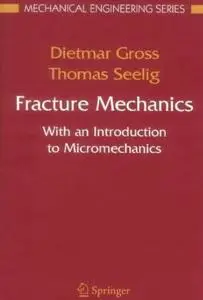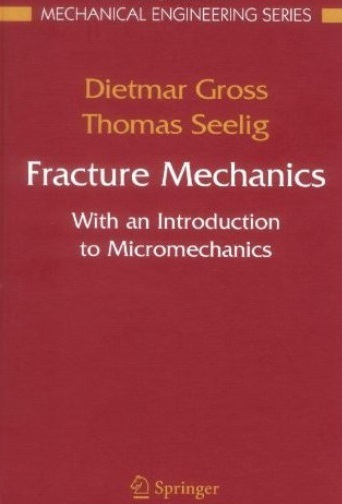"Fracture Mechanics: With an Introduction to Micromechanics" by Dietmar Gross, Thomas Seelig
Mechanical Engineering Series
Sper | 2006 | ISBN: 3540240349 9783540240341 | 323 pages | PDF | 5 MB
Mechanical Engineering Series
Sper | 2006 | ISBN: 3540240349 9783540240341 | 323 pages | PDF | 5 MB
This book has evolved from lectures on fracture mechanics and micromechanics which we held for students of engineering and natural sciences over the years. A major part of the book is devoted to linear elastic and elastic-plastic fracture mechanics. Further subjects are creep fracture, dynamic fracture mechanics, damage mechanics, probabilistic fracture mechanics, failure of thin films and fracture of piezoelectric materials.
The book also contains an extensive introduction into micromechanics. Self-contained and well-illustrated, this text serves as a graduate-level text and reference.
Throughout the previous three editions the contents of the book has successively been extended. It originated from a textbook solely on fracture mechanics by the first author alone. In the third edition, it was in collaboration with the second author supplemented with a chapter on micromechanics to account for the increasing utilization of micromechanical modeling in the treatment of fracture problems.
Contents
Introduction
1 Elements of solid mechanics
1.1 Stress
1.1.1 Stress vector
1.1.2 Stress tensor
1.1.3 Equilibrium conditions
1.2 Deformation and strain
1.2.1 Strain tensor
1.2.2 Strain rate
1.3 Constitutive laws
1.3.1 Elasticity
1.3.2 Viscoelasticity
1.3.3 Plasticity
1.4 Energy principles
1.4.1 Energy balance
1.4.2 Principle of virtual work
1.4.3 Theorems of Clapeyron and Betti
1.5 Plane problems
1.5.1 Plane stress, plane strain, longitudinal shear
1.5.2 Linear elasticity, complex method
1.5.3 Perfectly plastic material, slip line fields
1.6 Further reading
2 Classical fracture and failure hypotheses
2.1 Basic concepts
2.2 Failure hypotheses
2.2.1 Principal stress hypothesis
2.2.2 Principal strain hypothesis
2.2.3 Strain energy hypothesis
2.2.4 Coulomb-Mohr hypothesis
2.2.5 Drucker-Prager hypothesis
2.3 Deformation behavior during failure
2.4 Further reading
3 Micro and macro phenomena of fracture
3.1 Microscopic aspects
3.1.1 Surface energy, theoretical strength
3.1.2 Microstructure and defects
3.1.3 Crack formation
3.2 Macroscopic aspects
3.2.1 Crack growth
3.2.2 Types of fracture
3.3 Further reading
4 Linear fracture mechanics
4.1 General remarks
4.2 Crack-tip field
4.2.1 Two-dimensional crack-tip fields
4.2.2 Mode-I crack-tip field
4.2.3 Three-dimensional crack-tip field
4.3 K-concept
4.4 K-factors
4.4.1 Examples
4.4.2 Integral equation formulation
4.4.3 Method of weight functions
4.4.4 Crack interaction
4.5 Fracture toughness KIc
4.6 Energy balance
4.6.1 Energy release during crack propagation
4.6.2 Energy release rate
4.6.3 Compliance, energy release rate, and K-factors
4.6.4 Energy balance, Griffith’s fracture criterion
4.6.5 J−integral
4.7 Small-scale yielding
4.7.1 Plastic zone size, Irwin’s crack length correction
4.7.2 Qualitative remarks on the plastic zone
4.8 Stable crack growth
4.9 Mixed-mode loading
4.10 Fatigue crack growth
4.11 Interface cracks
4.12 Piezoelectric materials
4.12.1 Basic principles
4.12.2 The crack in a ferroelectric material
4.13 Further reading
5 Elastic-plastic fracture mechanics
5.1 Introduction
5.2 Dugdale model
5.3 Crack-tip field
5.3.1 Perfectly plastic material
5.3.2 Total strain theory, HRR−field
5.4 Fracture criterion
5.5 Determination of J
5.6 Determination of Jc
5.7 Crack propagation
5.7.1 J–controlled crack growth
5.7.2 Stable crack growth
5.7.3 Steady-state crack growth
5.8 Essential work of fracture
5.9 Further reading
6 Creep fracture
6.1 Introduction
6.2 Fracture of linear viscoelastic materials
6.2.1 Crack-tip field, elastic-viscoelastic analogy
6.2.2 Fracture concept
6.2.3 Crack propagation
6.3 Creep fracture of nonlinear materials
6.3.1 Secondary creep, constitutive law
6.3.2 Stationary crack, crack-tip field, loading parameters
6.3.3 Creep crack growth
6.4 Further reading
7 Dynamic fracture mechanics
7.1 Introduction
7.2 Some foundations of elastodynamics
7.3 Dynamic loading of a stationary crack
7.3.1 Crack-tip field, K-concept
7.3.2 Energy release rate, energetic fracture criterion
7.3.3 Examples
7.4 Crack propagation
7.4.1 Crack-tip field
7.4.2 Energy release rate
7.4.3 Fracture concept, crack-tip speed, crack branching,
crack arrest
7.4.4 Examples
7.5 Further reading
8 Micromechanics and homogenization
8.1 Introduction
8.2 Selected defects and fundamental solutions
8.2.1 Eigenstrain, Eshelby’s result, defect energies
8.2.2 Inhomogeneities, the concept of equivalent eigenstrain
8.3 Effective elastic properties
8.3.1 Foundations; RVE concept, averaging
8.3.2 Analytical approximations
8.3.3 Energy methods and bounds
8.4 Homogenization of elastic-plastic materials
8.4.1 Foundations; macroscopic plastic strain, dissipation,
macroscopic yield condition
8.4.2 Approximations
8.5 Thermoelastic material
8.6 Further reading
9 Damage mechanics
9.1 Introduction
9.2 Foundations
9.3 Brittle damage
9.4 Ductile damage
9.4.1 Void growth
9.4.2 Damage models
9.4.3 Fracture concept
9.5 Further reading
10 Probabilistic fracture mechanics 303
10.1 Introduction
10.2 Foundations
10.3 Statistical fracture concept of Weibull
10.3.1 Fracture probability
10.3.2 Fracture stress
10.3.3 Generalizations
10.4 Probabilistic fracture mechanical analysis
10.5 Further reading
Index
with TOC BookMarkLinks



